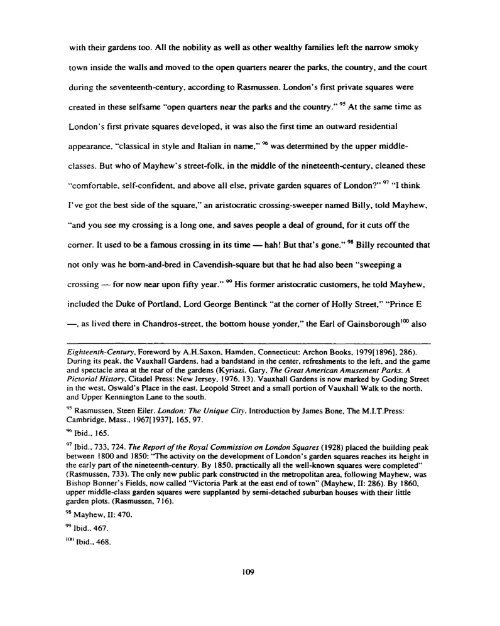You also want an ePaper? Increase the reach of your titles
YUMPU automatically turns print PDFs into web optimized ePapers that Google loves.
with their gardens too. All the nobility as well as other wealthy families left the narrow smoky<br />
town inside the walls and moved to the open quarters nearer the parks, the country, and the court<br />
during the seventeenth-century. according to Rasmussen. London's first private squares were<br />
created in these selfsame "open quarters near the parks and the country." 95 .4t the same time as<br />
London's first private squares developed. it was also the first time an outward residential<br />
appearance. "classical in style and Italian in name," 96 was determined by the upper middle-<br />
classes. But who of Mayhew's street-folk. in the middle of the nineteenth-century, cleaned these<br />
*'comfortable. self-confident. and above all else, private garden squares of London" '' '"I think<br />
I've got the best side of the square," an aristocratic crossing-sweeper named Billy, told Mayhew,<br />
"and you see my crossing is a long one, and saves people a deal of ground, for it cuts off the<br />
comer. It used to be a famous crossing in its time - hah! But that's gone." " Billy recounted that<br />
not only was he born-and-bred in Cavendish-square but that he had also been "sweeping a<br />
crossing - for now near upon fifty year." * His former aristocratic customers, he told Mayhew,<br />
included the Duke of Portland, Lord George Bentinck "at the comer of Holly Street," "Prince E<br />
-. as lived there in Chandros-street. the bottom house yonder." the Earl of ~ ainsborou~h'~ also<br />
Eighteenrh-Century, Foreword by A.H.Saxon, Hamden. Connecticut: Archon Books. 1979[ 18961,286).<br />
During its peak. the Vauxhall Gardens. had a bandstand in the center. refreshments to the left. and the game<br />
and spectacle area at the rear of the gardens (Kyriazi. Gay. The Great American Amusernenr Parks. A<br />
Pictorial History. Citadel Press: New Jersey. 1976. 13). Vauxhall Gardens is now marked by Goding Street<br />
in the west. Oswald's Place in the east, Leopold Street and a small portion of Vauxhall Walk to the north.<br />
and Upper Kennington Lane to the south.<br />
'' Rasmussen. Steen Eiler. London: The Unique Cizy. Introduction by James Bone. The M.I.T.Press:<br />
Cambridge. Mass., l967[ 19371, 165.97.<br />
97<br />
Ibid.. 733.724. The Repon of the Royal Commission on London Squares (1 928) placed the building peak<br />
between 1800 and 1850: 'The activity on the development of London's garden squares reaches its height in<br />
the early part of the nineteenth-century. By 1850, practically all the well-known squares were completed"<br />
(Rasmussen, 733). The only new public park constructed in the metropolitan area, following Mayhew, was<br />
Bishop Bonner's Fields. now called "Victoria Park at the east end of town" (Mayhew, 11: 286). By 1860,<br />
upper middle-class garden squares were supplanted by semi-detached suburban houses with their little<br />
garden plots. (Rasmussen, 7 16).<br />
9s Mayhew, 11: 470.<br />
99<br />
Ibid.. 467.<br />
"*' Ibid., 468.
















